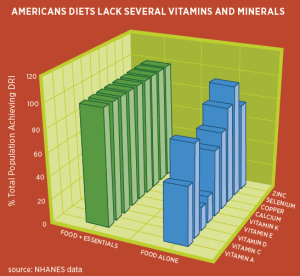The majority of Americans don’t get enough of the nutrients that are essential for lifelong health, according to the latest national survey research.
The National Health and Nutrition Examination Survey (NHANES) 2009–2010 reveals a grim picture of Americans’ health. According to the survey data, nearly the entire U.S. population is at risk of vitamin and mineral inadequacy, which is associated with increased risk of chronic disease (1-3).
- 65% or greater fail to meet daily recommended dietary intakes (DRIs) for vitamin E
- 25 percent or greater fail to meet DRIs for calcium
- 75 percent or greater fail to meet DRIs for vitamin D
- 5 to 25 percent fail to meet DRIs for B vitamins (folate, B12, B6, and niacin)
- 55 percent or greater fail to meet DRIs for magnesium
- 50 percent or greater fail to meet DRIs for vitamin A
- 20 percent or greater fail to meet DRIs for vitamin C
- 25 percent or greater fail to meet DRIs for zinc
- 10 percent or greater fail to meet DRIs for folate
Food that is lacking in nutrients because of processing and poor agricultural practices contribute to these inadequacies. Inadequate nutrient intakes are shocking in a country that currently also faces an epidemic of overeating and obesity, which can lead to greater requirements for vitamins and minerals.
Top the statistics off with the knowledge that there still exists considerable debate over whether or not current DRIs are high enough for optimal nourishment. For example, several nutrition researchers have called for raising the DRI for vitamin C, E, and D (4-6). While the current dosages are set to prevent deficiency and the associated diseases (such as scurvy), significant health benefits may be gained by increasing intakes.
Furthermore, age and genetics can sometimes predispose specific populations for increased need of certain vitamins and minerals for healthy metabolism and cellular function. These include vitamin D, vitamin B12, folate, and selenium (7;8).
The Truth About Supplements
Consumers who understand that not getting enough essential nutrients can put their health at risk turn to use of supplements. Of more than half of Americans who used dietary supplements from 2003-2006, nearly 40 percent reported using multivitamin/minerals (9). Clearly, supplements are a convenient and useful tool for easily obtaining optimal doses of nutrients to complement diet and to meet DRIs.
But some media reports would have consumers believe otherwise—that taking a multivitamin produces little benefit. However, many of these reports tend to “cherry pick” single studies with questionable endpoints, downplay other more meaningful studies, and contradict the findings of the totality of the scientific literature (10-12).
After reviewing the entire span of epidemiology and randomized controlled trials, the larger picture indicates that vitamin and mineral supplements—that combine therapeutic dosages, quality forms, and are designed to ensure absorption and bioavailability—are entirely safe and support overall health (10-12).
Essentials for Men™ or Essentials for Women™
The groundwork for the most advanced vitamin and mineral supplement was laid out in Isagenix Essentials for Men and Essentials for Women. With several features that set it apart from other typical “multis,” the product stands on its own as a unique solution for maintaining healthy cellular function and metabolism.
The Research and Science team at Isagenix carried out a thorough review of nutritional literature to identify dosages and forms supported by science. The result is a unique formulation of essential vitamins and minerals to support optimal nutrition. For example, Isagenix Essentials for Men or Women helps ensure consumers meet DRIs for vitamin D, vitamin E, vitamin A, vitamin C, B vitamins (B6, B12, niacin, riboflavin, and folate), selenium, zinc, copper, and more. These nutrients are necessary for healthy metabolic and cellular function across several tissues and organs including the brain, the heart, the liver, bones, muscles, and eyes.
Careful attention to absorption and bioavailability of vitamins and minerals also ensures efficacy of the nutrients. Essentials for Men and Essentials for Women combines a rapid disintegration technology with cautious regard for nutrient competitiveness and possible anti-nutrients (e.g. phytates) that could impede absorption. A timed dose, in the morning and in the evening with food, also assists in achieving optimal absorption and bioavailability.
In summary, Essentials for Men or Essentials for Women offers several unique advantages over typical multivitamin supplements:
- Therapeutic dosages and forms based on totality of scientific literature for ensuring optimal metabolic and cellular function
- Rapid disintegration technology for greatest absorption
- Cautious regard for nutrient competitiveness and anti-nutrients that could impede absorption
- Timed dose (taken in the morning and evening with meals) to promote bioavailability
- Greater solubility for better absorption using different forms of nutrients
To learn how to obtain ultimate convenience and extended benefits, read why Essentials for Men or Women is best taken as part of Ageless Essentials™ with Product B™.
References
- Centers for Disease Control and Prevention. National Health and Nutrition Examination Survey (NHANES) 2009-2010. Available at: http://wwwn.cdc.gov/nchs/nhanes/search/nhanes09_10.aspx
- Fulgoni et al. Foods, fortificants, and supplements: Where do Americans get their nutrients? J Nutr 2011;141:1847-54
- Vorland C. Multivitamins: Is the debate over? American Society for Nutrition 2014 Jan 6 [online]. Available at: http://www.nutrition.org/asnblog/2014/01/multivitamins-is-the-debate-over/
- Holick MF, Binkley NC, Bischoff-Ferrari HA et al. Evaluation, treatment, and prevention of vitamin D deficiency: an Endocrine Society clinical practice guideline. J Clin Endocrinol Metab 2011;96:1911-30.
- Vissers MCM, Bozonet SM, Perason JF and Braithwaite LJ. Dietary ascorbate intake affects steady state tissue concentrations in vitamin C-deficient mice. Am J Clin Nutr 93(2):292-301, 2011.
- Traber MG. Mechanisms for the Prevention of Vitamin E Excess. J Lipid Res, 2013; DOI: 10.1194/jlr.R032946
- Food and Nutrition Board. Institute of Medicine. Dietary Reference intakes. Washington, DC: National Academy Press, 2000, pp. 186-283.
- Gropper SS, Smith JL, Groff JL. Advanced Nutrition and Human Metabolism. Belmont, CA: Thomson Wadsworth, 2009.
- Gahche et al. Dietary Supplement Use Among U.S. Adults Has Increased Since NHANES III (1988–1994). NCHS Data Brief 2011:61.
- Comerford KB. Recent developments in multivitamin/mineral research. Adv Nutr 2013(4): 644-656, 2013.
- Linus Pauling Institute. The Case is Far from Closed for Vitamin and Mineral Supplements! December, 2013. Available at: http://lpi.oregonstate.edu/news/enoughisenough-response.html
- Ritz B. Beyond the media blitz: coming to real conclusions on recent multivitamin research. Newhope360. Available at: http://newhope360.com/breaking-news/beyond-media-blitz-coming-real-conclusionsrecent-multivitamin-research







